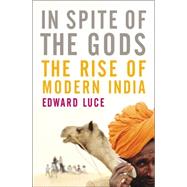
EDWARD LUCE is the Washington commentator for the Financial Times. He was the paper’s South Asia bureau chief, based in New Delhi, between 2001 and 2006. From 1999–2000, Luce worked in the Clinton administration as the speechwriter to Treasury secretary Larry Summers. Oxford educated and married into an Indian family, he now lives in Washington, D.C.
| Preface | vii | ||
| INTRODUCTION | 1 | ||
| 1. GLOBAL AND MEDIEVAL India's Schizophrenic Economy | 23 | ||
| 2. THE BURRA SAHIBS: The Long Tentacles of India's State | 63 | ||
| 3. BATTLES OF THE RIGHTEOUS: The Rise of India's Lower Castes | 105 | ||
| 4. THE IMAGINARY HORSE: The Continuing Threat of Hindu Nationalism | 143 | ||
| 5. LONG LIVE THE SYCOPHANTS!: The Congress Party's Continuing Love Affair with the Nehru-Gandhi Dynasty | 180 | ||
| 6. MANY CRESCENTS: South Asia's Divided Muslims | 218 | ||
| 7. A TRIANGULAR DANCE: Why India's Relations with the United States and China Will Shape the World in the Twenty-first Century | 257 | ||
| 8. NEW INDIA, OLD INDIA: The Many-Layered Character of Indian Modernity | 295 | ||
| CONCLUSION: HERS TO LOSE: India's Huge Opportunities and Challenges in the Twenty-first Century | 328 | ||
| NOTES | 357 | ||
| INDEX | 369 |
The New copy of this book will include any supplemental materials advertised. Please check the title of the book to determine if it should include any access cards, study guides, lab manuals, CDs, etc.
The Used, Rental and eBook copies of this book are not guaranteed to include any supplemental materials. Typically, only the book itself is included. This is true even if the title states it includes any access cards, study guides, lab manuals, CDs, etc.
Excerpted from In Spite of the Gods: The Strange Rise of Modern India by Edward Luce
All rights reserved by the original copyright owners. Excerpts are provided for display purposes only and may not be reproduced, reprinted or distributed without the written permission of the publisher.